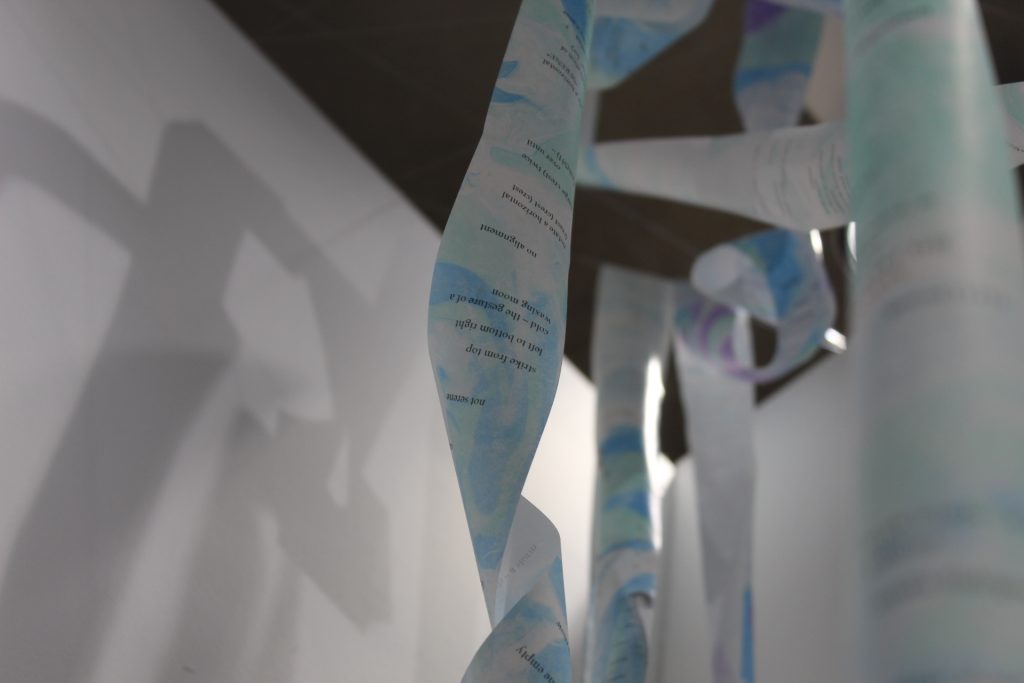
By Charisse Hau
Words from the Wild: The Nature of Poetry is an exhibition exploring different forms of poetry in response to the natural world. The exhibition has been curated by Royal Holloway and TECHNE researchers Caroline Harris, Briony Hughes, and Gareth Hughes, in collaboration with the Royal Holloway Culture Team.
In exploring the interplays between materiality and ecopoetry, I had the chance to talk to one of the curators, Briony Hughes, who is also a visiting tutor in English and Creative Writing, and PhD candidate.
There are so many intersections between material, and poetry. Why and how is that used in this exhibition?
“All of the poets in the space agree that a shift in climate necessitates a shift in how we approach poetic writing, and in particular, a shift in previously inherited structures including the page and the traditional codex book.
By using different materials, the interplay between those different materials in these poetic works is almost a version of that [nature], reflected through writing. You will notice that across many of these exhibited works, text is multi-directional: we are completely ignoring the left-hand margin of the page. Poetry becomes something that spills beyond the page, and beyond human structures we usually adhere to.”
Could you talk more about your own creative process in bringing these materials and poetry together?
“Weather Dialogue ” (2023, thermoprinted hand-marbled scrolls) is actually a performance object that has been framed as an installation for this exhibition. I was working with a bunch of archival materials documenting the weather, including Edward Holyoke’s almanack held in the Harvard University archives. After drafting the poem, I thought when I’m performing the poem how do I use my body to communicate the weather patterns, as I wanted to think about my body in dialogue with what’s going on in the natural world.
Essentially, it’s a very large scroll but before it is unravelled it can be held in the palm of your hand. When I last performed the work, I unravelled it and allowed it to accumulate around my body. If there’s enough space, I would run around and wrap it around myself, to make sure the poem and myself are part of the same structure.
Each section of the Weather Dialogue scroll is hand marbled. I was looking at COP26 which was happening in Glasgow (in 2021), the branding was this digital marbled globe. And the whole idea was when thinking about climate crises there should be no boundaries between geographies and no boundaries between different communities, and the weather systems don’t adhere to national boundaries either. So, I was using the craft technique of marbling to kind of gesture towards that marketing material. It was actually made for an event Royal Holloway ran for COP26, so it was directly responding to COP26.”
Looking into the future, we always talk about the digital and AI. What do you think about having digital also interacting with materiality? In the future of poetry, do you think digital will replace material?
“What I am seeing at the moment is, material objects, material poetries are having a moment – check out Astra Papachristodoulou’s Poem Atlas project! At the same time, digital poetries is also having a moment. And actually, exhibitions like this allow both of those worlds, both of the directions poets are going in, to expand on the traditional book, positioned side-by-side.
For example, J. R. Carpenter’s The Pleasure of the Coast (2023) is a digital piece – a web-based hydro-graphic novel – but it’s also a perfect-bound book published by Pamenar Press. And it’s also a tiny zine as well. So, there’s an interplay between what is digital, what is physical, what is material, and, to some extent, traditional publication.
What I think is nice about the space is it is in a contained moment in time, and in a contained geography. However, we are able to use the digital to expand it. We are going to have a 360 degree online digital tour of the exhibition that would be permanent, which means that the digital allows these physical objects placed in proximity to each other to continue to exist in time on the internet.
Also, Liz K Miller’s Forest Listening (2019) could be read as a movement back-and-forth between the digital and the physical. The artist took specialist equipment, to make recordings of the sound of water moving through trees. Miller is using scientific data in order to generate quite a physical material art practice.”
Can you share with us any ongoing or future projects?
“On the topic of the relationship between digital and material printing processes, I’d love to share more about an exciting project our MA in Creative Writing (Poetic Practice pathway) students are undertaking. The group has been working in the School of Advanced Studies MakerSpace Hub, a workshop space dedicated to digitisation and experimentation in printing. The students are learning to 3D print objects, including types which will be used for traditional relief printing. They’re engaging in such a radical interplay between digital and material craft.
Alongside the internationally acclaimed poets featured in this exhibition, such as Redell Olsen, Susan Johanknecht, Katharine Meynell, Kate Siklosi, and J. R. Carpenter, works from a number of former students of the Poetic Practice pathway are featured in the exhibition – examples include Hannah Harding and Tanicia Pratt.”
Words from the Wild: The Nature of Poetry Exhibition is open from 17 January 2024 to 24 March 2024 in the Davison Building Exhibition Space.
